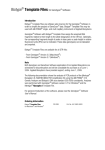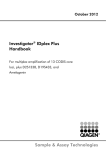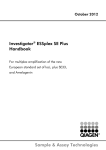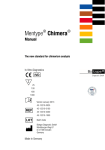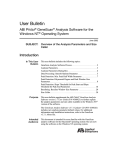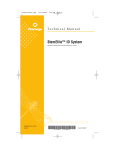Download Biotype ® Template Files for GeneMapper
Transcript
Biotype® Template Files for GeneMapper ID Software Introduction Biotype® Template Files are software sets for the GeneMapper ID Software in order to simplify the evaluation of analysis data. Biotype® Template Files may be used with ABI PRISM® single- and multi capillary instruments of Applied Biosystems. GeneMapper ID Software with Biotype® Template Files assigns the analyzed DNA fragments relative to their length to the allele designation of the STR loci. Optionally, the corresponding fragment length of peaks in base pairs or peak height in relative fluorescent units (RFU) can be indicated. These data (genotypes) can be tabulated and exported. Biotype® Template Files are available for all STR-kits from GeneMapper ID software version 3.1. The following documentation shows the analysis of PCR products of the Mentype® Nonaplex I (6-FAM/HEX/NED) PCR Amplification Kit using ABI PRISM® 310 Genetic Analyzer and Biotype’s DNA Size Standard 550 (ROX) consistently. Analyses were performed with GeneMapper ID Software version 3.2.1 and Mentype® Nonaplex I Template File. For general introductions of the software, please read the GeneMapper ID software User Guide. More info about Human Identification products (HID) from Applied Biosystems: https://products.appliedbiosystems.com/ab/en/US/adirect/ab - Products - Human Identification and Forensic DNA - Software Validity for HID The Biotype STR-Kits require a calibration with an allelic ladder. Therefore, the software used must be compatible with human identification (HID) products for forensic applications. This Biotype Template Files are valid with GeneMapper ID software. Ordering Information Biotype® Template Files for Windows® CD-ROM Cat. No. 49-10900-0000 -2- Content 1 Setup on the Analysis Computer.............................................................. 3 1.1 Login...................................................................................................... 3 1.2 Panel Manager ....................................................................................... 4 1.3 GeneMapper Manager............................................................................. 5 2 Calibration using Allelic Ladders.............................................................. 6 3 Evaluation of Analysis Data ..................................................................... 7 4 Template Files for Biotype® Test Kits..................................................... 10 A. Size Standards ................................................................................... 11 B. Panels and BinSets ............................................................................. 12 C. Analysis Methods................................................................................ 14 D. Plot Settings....................................................................................... 22 E. Table Settings .................................................................................... 24 5 Check Analysis Data............................................................................. 27 6 Print Options and Page Setup ............................................................... 31 7 Troubleshooting Guide.......................................................................... 32 GeneMapper ID Template Files March 2010 -3- 1 Setup on the Analysis Computer Biotype® Template Files for GeneMapper ID Software are available as free downloads from our homepage www.biotype.de or as CD-ROM on request. Before using the GeneMapper ID Software for the first time Biotype® Template Files either have to be saved to the local analysis computer (Windows® PC) or can be imported directly from intranet or CD-ROM. Panels and BinSets are imported by the Panel Manager. Other template files like Analysis Methods, Table Settings, Plot Settings, etc. are importable to the local PC by the GeneMapper Manager. 1.1 Login - Open GeneMapper Software and login - First Login User Name → “gmid” old Password → (none) - Change password Tools → Options → Users → New User - Repeat procedure in order to register new users and passwords GeneMapper ID Template Files March 2010 -4- 1.2 Panel Manager Use Panel Manager to import Panels and BinSets for Biotype® products into the GeneMapper ID software. Recommendation: For Biotype’s Panels and BinSets install a “Biotype folder” (AppliedBiosystems → GeneMapper → Panels → Biotype). Content: Biotype_Panels_v3 (or current version) Biotype_Bins_v3 (or current version) - Tools → Panel Manager - File → Import Panels Select the folder Panel Manager, mark the designated panel version and import. - File → Import BinSet Select the corresponding Panel from the Panel Manager, mark the equivalent BinSet version and import (see Figure 1). Fig. 1 Import of Panels and BinSets - Apply → OK - New Panels and BinSets could be generated in the Panel Manager. GeneMapper ID Template Files March 2010 -5- 1.3 GeneMapper Manager Use GeneMapper ID Manager to import Analysis Methods, Table Settings, Plot Settings, or Size Standards for Biotype® products into the GeneMapper ID software. Recommendation: Further Biotype® Template Files like analysis methods, Table Settings, Plot Settings or Size Standards should be saved as new folders onto the local computer (AppliedBiosystems → GeneMapper → new folder). - Tools → GeneMapper Manager Select the designated tab and click the button Import - Analysis Method → Import - Table Setting → Import - Plot Setting → Import - Size Standard → Import Imported Analysis Methods, Table Settings, Plot Settings or Size Standards could be redefined and saved by the user. New Analysis Methods, Table Settings, Plot Settings or Size Standards could be generated in the GeneMapper Manager and should be compiled in Advanced version. GeneMapper ID Template Files March 2010 -6- 2 Calibration using Allelic Ladders Workings with the GeneMapper ID Software are done with related analysis data, i.e. analyzed DNA samples with allelic ladders of one folder (Project). To analyse DNA samples with the GeneMapper ID Software, calibration with the allelic ladder has to be done. The allelic ladder of the used test kit should be analysed ideally at the beginning and the end of the DNA samples. For calibration the measured allele sizes are transferred automatically to the expected sizes within the project. In general, calibration bases on one appropriate run of the allelic ladder. If more runs will be used, calibration is implemented with the means of all allelic ladders. The correct assignment of the alleles should be reviewed. If not, DNA samples should be further runs with an appropriate allelic ladder. Calibration using Multi-Capillary Analysers To ensure a reliable allelic assignment on multi-capillary analysers, a number of allelic ladders should be run on different capillaries. The room temperature might influence the running performance of PCR products that might result in split peaks especially at low temperatures or an altered run velocity of DNA fragments. Please pay attention to keep conditions recommended by the instrument manufacturer. System Parameters Different analysis instruments, DNA size standards or polymers may result in different fragment lengths. Thus, DNA samples and allelic ladders from one sample set should be analysed using the same system parameters. GeneMapper ID Template Files March 2010 -7- 3 Evaluation of Analysis Data - Open GeneMapper ID Software and login - Import data File → Add Samples to Project - Select Analysis Data Files (.fsa) Add Samples → Add to List → Add - Select Table Setting via pull-down menu at the top of the centre, use Table for 2 Alleles for samples with one DNA (use Table for 10 Alleles for DNA mixtures) - Data Files appear as new project in the Samples tab. The table sheet displays the following columns: Status, Sample Name, Sample Type, Analysis Method, Panel, Size Standard, Matrix as well as the quality values SQO*, SFNF*, OS*, SQ*, UD1* (PQV explanation in table 1). Table 1. Process quality values (PQV) PQV* Definition SQO Sizing Quality Overridden: size calling of the sample overridden SFNF Sample File Not Found OS Off-scales: signals are outside of the scaling, pull-up peaks in other colors SQ Sizing Quality: size calling of the sample or allelic ladder UD1 User Defined Column 1: For more information, please check the chapter Process Quality Values of the GeneMapper ID Software User Guide. - Select Sample Typ via pull-down menu (e. g. Sample, Allelic Ladder, Positive Control, Negative Control, etc., see Figure 3). One project has to contain at least one allelic ladder. Optionally, data of the control DNA might serve as positive control, data without DNA as negative control. GeneMapper ID Template Files March 2010 -8- - Select Analysis Method via pull-down menu (e. g. Biotype® template: Analysis_HID_310) The analysis method is already prepared for evaluation of data from Windows® PC (= Advanced Peak Detection) for ABI PRISM® 310 instruments. There are other methods for ABI PRISM® multi capillary instruments like 3130, etc. Important Annotation New analysis methods refer to the last BinSets used of the GeneMapper ID Software. For Biotype® products, please select the updated Biotype BinSets (e. g. Biotype_Bins_v3) from the tab Allele (see Figure 2). Fig. 2 Analysis Method, tab Allele, check here Adjustment of the BinSet - Select Panel via pull-down menu, e. g. Nonaplex_I_Panels_v2 - Select Size Standard via pull-down menu, e. g. SST-ROX_50-400bp for the DNA Size Standard 550 (ROX) - Matrix for ABI PRISM® 310 samples is shown (not for ABI PRISM® multi capillary instruments, e.g. 3130 samples) - Click onto the green arrow ►-Icon in order to start Analysis, name the project and save it. If the analysis worked well, the icon disappears from the column Status (see Figure 3) Fig. 3 Start Analysis Annotation Use the function Fill Down in order to analyse all samples with the same parameters. Select the parameter (e. g. Nonaplex_I_Panels_v2), mark the top column via the pull-down menu and press Strg + D or do Edit → Fill Down. GeneMapper ID Template Files March 2010 -9- Project Analysis - Select data Edit → Select All Analysis → Display Plot - Select Plot Setting via pull-down menu e. g. Plot_4dyes (for the blue/green/yellow/red panel) Scaling of the Analysis Range In order to scale up the analysis range of the test kit (e. g. Nonaplex I / ca. 75405 bp), click the magnifying-glass-icon atop the horizontal scale in front of the first possible allele and pull it behind the last possible allele. To return to basic setting, double-click onto the scale. Fig. 4 Scaling of the Analysis Range in Sample Plot GeneMapper ID Template Files March 2010 - 10 - 4 Template Files for Biotype® Test Kits A. Size Standards B. C. Panels BinSets Analysis Method D. Plot Settings E. Table Settings SST-ROX_50-500bp SST-BTO_60-500bp Biotype_Panels Biotype_Bins Analysis_HID_310 Analysis_HID_3130 Analysis_HID_310_50rfu Analysis_HID_3130_50rfu Plots_2dyes Plots_3dyes Plots_4dyes PlotsBT5_4dyes Plots_5dyes Table for 2 Alleles Table for 10 Alleles Panels and BinSets always need to be executed whereas the use of additional Template Files is facultative. GeneMapper ID Template Files March 2010 - 11 - A. Size Standards SST-ROX To check the correct assignment of the labels to the sample, click the colour panel of the Size Standard (red icon) in the upper toolbar of the GeneMapper ID Software. Thus, the red panels (DNA Size Standard) of all samples are displayed. Compare the sample fragments sizes with the sizes of the DNA Size Standard 550 (ROX) that should be 50, 60, 70, 80, 90, 100, 120, 140, 160, 180, 190, 200, 220, 240, 260, 280, 300, 320, 340, 360, 380, 400, 425, 450, 475, 500, 525 and 550 bp. If sizes differ, further analysis should be performed with GeneMapper ID Software. If necessary, create a new size standard definition within the GeneMapper ID Software. Adjustment of the basic template The basic template SST-ROX_50-500 bp defines all fragments from 50 bp to 500 bp (see figure 5). If for example only 400 bp are necessary for analysis of a particular test kit, define fragment length just up to 400 bp. The new template could be saved as e.g. SST-ROX_50-400bp and used for further analyses. Fig. 5 Electropherogram of the DNA Size Standard 550 (ROX), Lengths of Fragments in bp Definition of a New Size Standard To define a new size standard, please perform the following steps: - Tools → GeneMapper Manager Select the tab Size Standards - New → Basic or Advanced Assign a name (e.g. SST-ROX_50-500bp) and define the size range on the lines of the analysis range of the corresponding test kit. See also horizontal scaling in the user´s manual. - Size Standard Dye Für SST-ROX=Red auswählen (für SST-BTO = Orange) SST-BTO For Biotype test kits in 5 Color Assay with the fluorescent labels 6-FAM, BTG, BTY, BTR, and BT0 (matrix BT5) the DNA Size Standard 550 (BTO) in orange Panel is necessary. Please use DNA Size Standard 550 (BTO) template SSTBTO_60-500bp to define fragment length for particular test kit. GeneMapper ID Template Files March 2010 - 12 - B. Panels and BinSets Panels The following features of the test kit’s markers (STR-Loci) are depicted: - Marker Name (STR Locus) - Dye Colour - Min. Size and Max. Size (upper and lower allelic range in bp) - Control Alleles (alleles of the Control DNA) - Marker Repeat (units of the repeats in bp) - Marker Specific Stutter Ratio („Stutter filter“, 0.13 corresponds to 13% of the marker’s peak height ) - Comments - Ladder Alleles (alleles of the allelic ladder, not shown) Fig. 6 Structure of a Panel GeneMapper ID Template Files March 2010 - 13 - BinSets The following features of the allelic designation are depicted: - Name (number of the allele) - Length of fragments (in bp) - Upper and lower range of tolerance (in bp) Fig. 7 Structure of a BinSet GeneMapper ID Template Files March 2010 - 14 - C. Analysis Methods There different analysis methods for ABI PRISM® single- and multi capillary instruments. ABI PRISM® single capillary instrument = ABI 310, multi capillary instruments = ABI 3130, etc. Analysis_HID_310 Analysis_HID_3130 Analysis_HID_310_50rfu Analysis_HID_3130_50rfu HID analysis method with 20% Filter for samples of one DNA HID analysis method with 20% Filter for samples of one DNA Sensitive HID analysis method for stains and DNA mixtures Sensitive HID analysis method for stains and DNA mixtures Note: This guide focuses on the HID_310 and HID_310_50rfu examples. Analysis_HID_310 - To analyze samples of one DNA, unsuitable for DNA mixtures - Label peaks according to filter values used. Peaks will be designated with the appropriate allele - Filter value pre-selection: Labels lower then 20% of the highest peak height of a marker (STR-locus) will not be displayed - In plot-window (Sample Plot), the labelled colour panels are displayed Fig. 8 Sample Plot after Execution of analysis method HID_310 Problems with importing analysis methods To solve import problems, please create own analysis methods in your GeneMapper ID software according to Applied Biosystems instructions and fill in the biotype setting of fig. 9-13. GeneMapper ID Template Files March 2010 - 15 - Analysis_HID_310 Fig. 9 Tab General describes the analysis method GeneMapper ID Template Files March 2010 - 16 - Analysis_HID_310 Fig. 10 Tab Allele Cut-off Value Cut-off Value 0.2 corresponds to 20% filter in comparison to the highest peak of a marker. With this setting all signals with peak heights less than 20% will not shown in plots and tables. Method limitation The methods Analysis_HID_310 and Analysis_HID_3130 contain a 20% filter and are unsuitable for the analysis of DNA mixtures. GeneMapper ID Template Files March 2010 - 17 - Analysis_HID_310 Fig. 11 Tab Peak Detector - For an improved peak detection especially for detection of point alleles (i. e. alleles with at least 1 bp difference to the next integer allele) the value for the Peak Window Size can be minimized to 11 pts. For improved peak detection, minimize the Peak Window Size further on. Only the setting for Peak Window Size is different to defaults from Applied Biosystems for HID analysis. GeneMapper ID Template Files March 2010 - 18 - Analysis_HID_310 Fig. 12 Tab Peak Quality, for adjustment of the peak quality parameters. All settings here are defaults from Applied Biosystems for HID analysis. GeneMapper ID Template Files March 2010 - 19 - Analysis_HID_310 Fig. 13 Tab Quality Flags for weighting of the peak quality parameters. All settings here are defaults from Applied Biosystems for HID analysis. GeneMapper ID Template Files March 2010 - 20 - Sensitive HID analysis method for stains and DNA mixtures Analysis_HID_310_50rfu Fig. 14 Tab Allele for adjustment of the filter values, pre-selection: No Cut-Off filter Changing the Filter Value in the Allele tab To change the lower thresholds please perform the following steps: - Tools → GeneMapper Manager - Select Analysis Method and edit via double-click - The following filter values can be changed in the tab Allele: Cut-off Value, MinusA, Minus Stutter, Plus Stutter (see figure 14) - Select the value you would like to change and save changes of the analysis method under a new name GeneMapper ID Template Files March 2010 - 21 - Analysis_HID_310_50rfu Fig. 15 Tab Peak Detector, pre-selection: 50rfu filter Changing the Filter Value in the Peak Detector tab - Peak Amplitude Threshold describes the minimal peak height which can be detected with the GeneMapper ID Software. Common values are 50-200 RFU and should be determined individually be the laboratory. Recommendation: The minimal peak height should be three times higher then the background noise of the baseline. GeneMapper ID Template Files March 2010 - 22 - D. Plot Settings Plots_2dyes Plots_3dyes Plots_4dyes PlotsBT5_4dyes Plots_5dyes Display of two colour panels (B, R) Display of three colour panels (B, G, R) Display of four colour panels (B, G, Y, R) Display of four colour panels (B, G, Y, O) Display of five colour panels (B, G, Y, R, O) Description - To compare samples with the appropriate allelic ladder - Shows the peak designation (e. g. allele) with the chosen analysis method - Designations of alleles can be changed - allelic ladders and defined control samples are fixed in the upper part of the window. In the lower part, DNA samples will be displayed - Zoom up the appropriate area in order to simplify allocation (see Figure 4 on page 9) - Plot Settings are initialised without tables Fig. 16 Plot Window with allelic ladder and DNA Sample GeneMapper ID Template Files March 2010 - 23 - New Peak Designations (Labels) To change peak designation, please perform the following steps: - Tools → GeneMapper Manager - Select Plot Setting and edit via double-click - The following designations can be adjusted in the tab Labels: Allele Call, Height, Size (see Figure 17) - Select the value which has to be changed or added and save the changing with OK Fig. 17 Plot Setting, Tab Labels for Designation of the Peaks - Designation of peaks which have to be displayed in the table is defined in the tab Sizing Table (see Figure 18) - Select the value which has to be changed or added and save the changing with OK Fig. 18 Plot Setting, Tab Sizing Table for Table Display GeneMapper ID Template Files March 2010 - 24 - E. Table Settings Table for 2 Alleles Table for 10 Alleles For samples with one DNA For samples with DNA Mixtures Table for 2 Alleles - To analyze samples of one DNA, e. g. for a DNA-database - Displays the allele designation of two peaks of each marker - Generates a table where the analysis of each marker (STR-Locus) is displayed in one line (e. g. Nonaplex I: all markers x 2 alleles) - The following columns are displayed in the tab Genotypes: Sample Name, Marker, Allele 1, Allele 2, as well as the quality values AE*, OS*, BIN*, PHR*, SPU*, AN*, BD*, CC*, GQ* (PQV explanation in table 2) Fig. 19 Output File after Execution of Table for 2 Alleles - In GeneMapper ID all quality criteria are pre-adjusted by Applied Biosystems for HID products. When a colour signal (Check, Low Quality) appears, a PQV was not hold. - Check the reason of the out range PQV in the table, use PQV explanation in table 2 Peak quality assessment via different signals: Signal Pass Check Low Quality Table green Icon (square) yellow icon (triangle) red Icon (stop) GeneMapper ID Template Files March 2010 - 25 - Table 2. Process Quality Values (PQV) PQV* Definition AE Allele Edit: OS Off-scales: signals are outside of the scaling, pull-up peaks in other colors BIN Out of bin allele: allele is outside Bin definition PHR Peak Height Ratio: indicates if the peak height ratio between the lowest and highest peak is less than defined in the analysis method SPU Spectral Pull-Up: spectral pull-peaks in another colour channel AN Allele Number: BD Broad Peaks: the allele peak is wider as expected (default 1.5 bp) CC Control Concordance: comparison with an internal control, e .g. Control DNA GQ Genotype Quality: quality of the DNA profile or allelic ladder For more information, please check the chapter Process Quality Values of the GeneMapper ID Software User Guide. GeneMapper ID Template Files March 2010 - 26 - Table for 10 Alleles - To analyze stains or mixed samples of different DNAs - Displays the allele designation of up to ten peaks of each marker - Generates a table where the analysis of each marker (STR-Locus) is displayed in one line (e. g. Nonaplex I: all markers x 10 alleles) - The following columns are displayed in the tab Genotypes: Sample Name, Marker, Allele 1 … Allele 10, as well as the quality values AE*, OS*, BIN*, PHR*, SPU*, BD*, CC*, GQ* (PQV explanation in table 2) Fig. 20 Output File after Execution of Table for 10 Alleles Table Export - Sample Plot with table has to be displayed - File → Export Table - In order to save add „.txt“ for tab-delimited text or „.csv“ for commadelimited text For general instructions for table export, please read the chapter Exporting Table Data from GeneMapper ID Software User Guide. GeneMapper ID Template Files March 2010 - 27 - 5 Check Analysis Data General Procedure for Analysis 1. Check Size Standard 2. Check Allelic Ladder 3. Check Positive Control 4. Check Negative Control 5. Review Sample Data Check Size Standard - The first step in any new project with low Size Quality (PQV=SQ) is to check the size standard for the correct fragments, named size calling (see chapter size standards). Fig. 21 Checking Size Calling GeneMapper ID Template Files March 2010 - 28 - Check Allelic Ladder - Second action is to check Allelic ladder, for correct allele calling Fig. 22 Checking Allelic Ladder Controls In order to check allele designations please compare the alleles of the allelic ladder and Control DNA of the test kit with data of the latest user’s manual. We recommend the quality value: - AN = Allele Number for checking the allelic ladder - CC = Control Concordance for the Positive Control GeneMapper ID Template Files March 2010 - 29 - Check Positive Control Fig. 23 Checking Control DNA Positive Control We recommend the following quality value: - Control Concordance for the Positive Control (=CC). Negative Control The negative control contains no DNA and is a helpful information for background signals of the current analysis conditions. GeneMapper ID Template Files March 2010 - 30 - Review Sample Data Fig. 24 Changing the Allele Designation Off-Ladder Allele Peaks labelled with OL (= Off-Ladder) could not be assigned to an allele size. These labels have to be checked manually and may be deleted or redefined by clicking on. Delete Allele - In order to change the allele designation of unrealized peaks, click onto the OL -icon below the peak (icon gets bold). Open pull-down menu by clicking onto the right mouse button and chose Delete Allele - Thereafter, window Add Allele Comment opens in order to take notes regarding to the changes. Rename Allele Inside the pull-down menu, known alleles of the marker can be chosen from the Bins. Predefine a new allele based on its length via Custom. GeneMapper ID Template Files March 2010 - 31 - Change Panels and BinSets Panels/BinSets data are saved locally on Windows® PC within the folder (AppliedBiosystems → GeneMapper → Panels → Biotype). In order to modify, open them with the Windows® Explorer via double-click (see chapter 4B). - Change date and version of the Panels and BinSets. Important: Version number of Panels and BinSets have to be identical in one version, e.g. v3 - Choose the allele and change its range of tolerance or fragment length - File → Save as - Load the new version of Panels and BinSets in the Panel Manager and delete the old version Annotation New categories can be created in the same way e.g. for newly found point alleles (SE33 20.1 etc.). The tolerance range of ±0.5 bp for all alleles and ±0.4 for point alleles respectively should be entered. Biotype assumes no liability for changing of Panels and BinSets. The actual versions for all test kits can be downloaded from the homepage www.biotype.de. 6 Print Options and Page Setup In Samples Plot the following print options can be chosen via File → Page Setup: - Table to edit i.e. size or typeface - Plot to choose one of four different settings: Honor plots per pane (to print data and/or plots onto one page) Small, Medium, Large (to scale the plot size per page) GeneMapper ID Template Files March 2010 - 32 - 7 Troubleshooting Guide General Help in software Click the menu Help → GeneMapper ID 3.2.1 Help in GeneMapper ID software and search the User Guide for your specific theme. Observation Possible Cause Comments Error message during saving data. Country setting Setting from the PC has to be edit to English (United States) Error message during import (Panels and BinSets) “unable to save panel data: java.SQLException: ORA00001: unique constraint (IFA.CKP_UK) violated.” Path on your computer AppliedBiosystems\GeneMapper and check text file Panel-ImportLog for error message First, delete all Panels in the Panel Manager, then import Panels/Bin Sets from the Biotype first. Panels and BinSets are not identified correctly. Compatible versions of Panels and BinSets have to be saved within one folder. Error message during import (Panels) “Invalid marker repeat value in line # for marker D10S2325. Valid marker repeat values are 2, 3, 4 & 9.” GeneMapper ID v3.1 does not identify penta repeat motives (5 bases) like the marker D10S2325 of the Humantype Chimera® test kit. Open panel txt.-data in Windows® Explorer and change the penta repeat motive of D10S2325 from 5 to 4. Then, import the new panel data again. Alternatively, install at least version 3.2 of GeneMapper ID Software. Error message during import (Analysis Method, Plot Setting, Table Setting, Size Standard) GeneMapper Software is not GeneMapper ID Software. Install GeneMapper ID Software. Essor message during analysis “There are samples that do not meet analysis requirements. Please see Error Message in the info view of each sample…” An invalid BinSet is preselected in Analysis Method. Select the actual BinSet. For Biotype® Templates Files (Panels and BinSets) always use the same version, e.g. v3 Data from different analysers like ABI 310 and ABI 3130 have been saved within one run folder. Data from different analysers always have to be saved within different run folders. Injection/file of the allelic ladder not appropriate An additional signal can be identified as peak of the allelic ladder because of dysfunctions during the electrophoresis. If peaks of the allelic ladder are miscalled, the ladder can not be used for the analysis. Use a different injection/file of the allelic ladder and check firstly the data of the analysed sizes from the Size Standard (in bp) of the allelic ladder. Always use the DNA Size Standard 550 for Biotype® test kits. One peak of the allelic ladder is below the Peak Detection Value (50-200 RFU) of the analysis method used which is not identified. The allelic ladder has to be load with higher concentration onto the analysis instrument. Alternatively, data of the allelic ladder can be analysed with a lower Peak Detection Value from GeneMapper ID Software. One peak of the allelic ladder is not identified because it is outside the expected size range of the software (in bp). First compare the length of the fragments (in bp) of the first allele in one colour of the allelic ladder with the corresponding value in the categories, then of the other alleles. GeneMapper ID Template Files March 2010 - 33 - Observation Possible Cause Comments Single marker is not identified. Various causes Open the “project” folder, mark the corresponding sample and check Error Message in the tab Info or PQV. Many peaks are termed OL as off-ladder alleles in the samples. DNA Size Standard 550 (ROX or BTO) was not defined or identified correctly. Click onto the red icon Size Match Editor in the upper toolbar or the GeneMapper ID Software. Check the red or orange fragments of all samples. Always use the internal DNA Size Standard 550 for Biotype® test kits. Too high intensities at the analysis instrument. If the peak heights of the samples are outside the linear detection range (>4000 RFU/ABI310; >5000 RFU/ABI3130), stutters, split peaks, and artefacts might be increased. Reduce the injection time up to 1 second, reduce the amount of the PCR amplification product for analysis, or reduce the quantity of DNA for PCR. Bubbles in the capillary lead to pull-up peaks in all colour panels („spikes”) that result in allele misnomer. Repeat electrophoresis to confirm results. Differences in the capillaries’ run performances of a multicapillary analyser might result in allelic assignment shift. For reliable allelic assignment on multi-capillary analysers, a number of allelic ladder should be run for further information see chapter “Electrophoresis” of the test kits’ manuals. Point alleles, i.e. alleles with at least 1 bp difference to the next integer allele (e. g. TH01 9.3/10), are not found. The point alleles were not separated in the GeneMapper ID Software. Check the settings of the analysis method. Lower the Peak Window Size value to 11 pts. Homocygote alleles are not displayed as duplicates in the table. Preferences of the GeneMapper ID Software Adjustment can be changed via Tools → Options choose the tab Analysis and the setting Duplicate homozygous alleles so that e. g. the homocygote allele 18 is displayed as 18/18. Trademarks 6-FAM, HEX, NED, ROX, ABI PRISM®, GeneScan®, Genotyper®, GeneMapper® and Applied Biosystems are trademarks of Life Technologies. Windows® is a trademark of Microsoft Corporation. GeneMapper ID Template Files March 2010

































